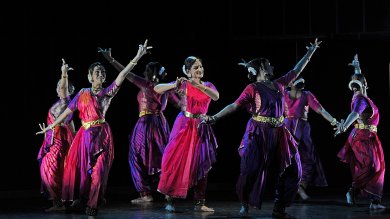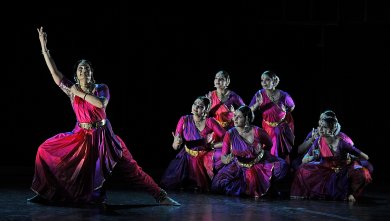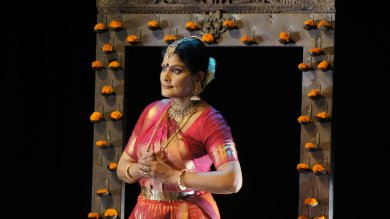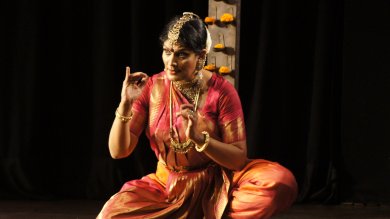
|   |

|   |
Geeta Chandran and her dancers present Bharatanatyam bliss - Shveta Arora e-mail: shwetananoop@gmail.com March 28, 2014 Within a few days of each other this month, Delhi based Geeta Chandran presented two productions, both beautifully executed. Natya Vrinda Spring is the season for flowering and that is what the group of dancers of the Natya Vriksha Company looked like – a bunch of vibrant roses. On the 5th of March, under the aegis of Impressario India, the Natya Vriksha Company organized a group choreography Natya Vrinda at the National Festival of Creative Arts at the India Habitat Centre in Delhi. Geeta Chandran has evolved a holistic method of teaching Bharatanatyam, training the students in both dance and dance aesthetics. When I asked her about the choreography of the spellbinding Raas sequence, she said, “It was so many years of going to Vrindavan for different festivals, the reading of related poetry and studying the paintings and the living tradition of Vrindavan that created a vision. But I had still not thought of putting it down in a production. It was just assimilated as an experience. Then I read this padavali and everything came alive. But still, it was not easy to externalize all the sentiments that I felt. Raas is such an extensively written about subject that one wonders how to do justice to it. Each time you feel bas itna hi hai raas mein (is that all there is to it). Raas is such a beautiful concept and to make it into a tangible reality is very difficult. So it was a challenge - we kept working on it and it is still a work in progress as I keep adding my experiences to it. At the same time, I did not want to lose the weight of classical Bharatanatyam. In group choreography, sometimes, you lose the significance of the classical. All these are fabulous dancers and I wanted to bring out their dancing talent. I wanted to knit the sentiment of raas with Bharatanatyam, the story of Krishna with the technique. So there were a lot of layers.” Just as Vadya Vrinda started by Pandit Ravi Shankar was an orchestra of various instruments, Natya Vrinda was a concert of bodies in the pristine classicism of Bharatanatyam. The production was in three parts – the first inspired by a temple setting, the second by community, and the third by the geography of imagination. The first piece was a Mallari, a processional number dedicated to the king of dancers, Nataraja. The piece elaborated on the attributes of the lord. Geeta portrayed the bliss of performing at the Chidambaram temple in this piece, with its infectious rhythm and energy. 

Pics by Rakesh Sahai
The second piece, Varsha Ritu, had lyrics from Ritusamhara by Kalidas.
This section of Natya Vrinda was inspired by the experience of
community. The imagery used by the poet alludes to the clouds as a
rushing herd of elephants, moving pell-mell. It is as if the monsoon is
like the bridegroom, being heralded by drums of thunder and lit by bolts
of lightning. The entire living world delights in rain. All of nature
is drenched with happiness and love. The peacocks celebrate this season
best. Their dance is the dance of love and joy, but the floods in their
fury cause devastation too.The dancers depicted the misery of the heat of summers, and then the sound of approaching clouds is welcome. Sasikara ambodara matta kunja – the thunder sounds like drums beating. The dancers depicted the elephant ears and their gait, and then the group formed a wedding procession with drummers and shehnai players. In nature, animals are enjoying the rain – the dancers showed the frolicking deer and the bees humming over the lotuses in the ponds. The peacock dance by the group was entrancing - the eye movement, the neck and the shoulder movements were all used to depict the peacocks looking at the clouds and gradually spreading their feathers to dance. Humans were shown playing and dancing with water in the rain. What was shown next was the ferocity of the floods, the rivers flowing with force and speed. The final section of this piece is about a young couple in the middle of a lover’s tiff. It was a solo with Geeta doing the abhinaya for both the nayaka and the nayika. While the nayika prepares her bed and readies herself in wait for the hero, she sprinkles perfume on herself. The nayaka comes in late and she is angered (roshita). In the middle of the tiff, the sound of thunder drives her into the hero’s arms out of fear. They are both entangled in an embrace, and then a kiss. The nayika puts out the light. The third sequence Raas, is about the sublime experience of maharaas, when Krishna danced with the gopis. Gopis symbolizing humans surrendered their selves and found the ecstasy of the union of the atma and paramatma. The choreography is inspired by the geography of imagination, and takes inspiration from the works of poets, painters, sculptors and craftsmen who have worked on the theme of raas. The lyrics of the composition are by saint poet Hitaharivansha. Khelat raas rasik braj mandal – raas is being played in Vrindavan by the one who is the rasika. Yuvatin ansh diye bujh Anshan – the gopis and Krishna are embracing each other with their arms. Sharad vimal navchandra viraaje – the moon is shining bright in the winter sky. The moon was depicted as a shadow in the river, and it is being gazed upon by the chakor (a bird enamoured of the moon). The gopis are the kanchan beli or the golden climbers on Krishna, the blue tree (shyam tamaal). Various instruments are playing (taal mridanga), as if many Kamadevas are singing. The gopis are wearing colourful saris and many ornaments, and the air is laden with various perfumes - Hitaharivansha magan man shyama, radha raman sakal sukh dhama. The entire piece was an ethereal experience, with some excellent abhinaya interspersed with high-energy nritta. It ended with Geeta as Krishna playing on the flute, and gopis adoring him. It was perfect in technique, group choreography, abhinaya, rhythm, music and singing. Concept and choreography was by Geeta Chandran. The dancers of the Natya Vriksha company accompanying her were Sneha Chakravardhar, Sharanya Chandran, Divya Saluja, Rashi Bijlani, R Amritha Shruti, Radhika Kathal and Megha Jaju Jha. For the recorded soundtrack, nattuvangam was by Geeta Chandran, vocals by Sudha Raghuraman, mridangam by Lalgudi Sriganesh, ghatam by Adambakam Shankar, ganjira by Raja Ganesh and flute by G Raghuraman. Dooti Vilasam Dooti Vilasam by Geeta Chandran was organized on the 15th of March at the Chinmaya Mission auditorium. It was a solo performance by Geeta, and adhered to the traditional margam of Bharatanatyam, but what made it strikingly different was the concept, its story, its execution, the energy and the expressive abhinaya. The performance was conceptualized in three sections – Just The Other Day, The Plea and Shattered Glass. The stage was set with a wooden doorway, decorated with flowers and a metal stool or pedestal. The first section, Just The Other Day, was a trip down memory lane – days of childhood and deep friendship, with all its headlong giddiness, days that you look upon with great nostalgia. The musical score was an original one with Sudha Raghuraman singing only taals, without any lyrics. Geeta went about portraying the childhood of the two girls, how they would pick fruits from the vines and eat together, or how they would play hopscotch, fight and cheat to outdo each other, playfully throw water on each other, expressing their fear of the big man with the moustache and being protective of each other, grannies combing their hair and plaiting them, getting ready to go to school with their big bags on their backs, enjoying studying together and copying from each other. Geeta did an exhilarating portrayal of the friendship, sharing and rivalry of the two friends. She danced around the door and the pedestal, using them to change the location of the scene. The girls become a little more mature and so do their playthings. They try on their mother’s ornaments and admire their looks. The sounds of the shehnai and the mridangam please them, for they harbour thoughts of marriage. They talk about love when one of them, the heroine, confesses to the other, her sakhi, about her attraction for the hero 

Pics by Anoop Arora
In the next sequence, unable to bear the torment of her friend in love,
the sakhi ventures to the hero and advocates her case to him. It is the
plea, and that is the reason why the sakhi becomes the dooti or the
messenger. It was a varnam in ragam Suruti, rupaka talam, composition by
Subbarama Dikshitar, conceptualized by Lalgudi Sriganesh. The heroine
is as beautiful as the moon. As she is tuning her sitar or going around
the house, decorating the door with flowers, she is deeply in thoughts
of the hero, and does ‘loves me-loves me not’ with a flower. The sakhi
approaches the palace of the hero and praises the heroine as the
vilasavati, sumati, gunavati (one having good brains and good
attributes). She relates the pain that the heroine is going through, as
she is struck by Kamadeva.The final sequence, Shattered Glass, shows the fragility of friendship, coming under the cloud of doubt and recrimination. Shattered Glass shows two traditional padams, with the colours of pain, anger and sarcasm. When the sakhi returns after pleading with the hero, the heroine begins to doubt her intentions as to whether her friend has herself had an affair with him. She has doubts as to what transpired between them. The heroine imagines the sakhi, her hair being combed and perfumed, being beautified with a kasturi tilakam, and embraced by the hero. The heroine takes out her frustration on the chores in the house, and goes about washing clothes while crying in anger. In the second padam, the sakhi, in jealousy, gossips about the wealth of the heroine, her palatial house, ornaments, guards and good fortune, and says that once upon a time, she would beg for them. But once they get together, they resolve their differences, for old times’ sake. They make good on their slander for each other, go out into the vines to pick fruits and eat them together. The concept, performance and choreography were by Geeta Chandran. Excellent vocals by Sudha Raghuraman, natuvangam by Guru S Shanker, mridangam by MV Chandrashekar, flute by G Raghuraman and costumes by Sandhya Raman enhanced the presentation. The lighting was designed by Deepa Dharmadhikari and rhythm inputs were by Lalgudi Sriganesh. Shveta Arora is a blogger based in Delhi. She writes about cultural events in the capital. |